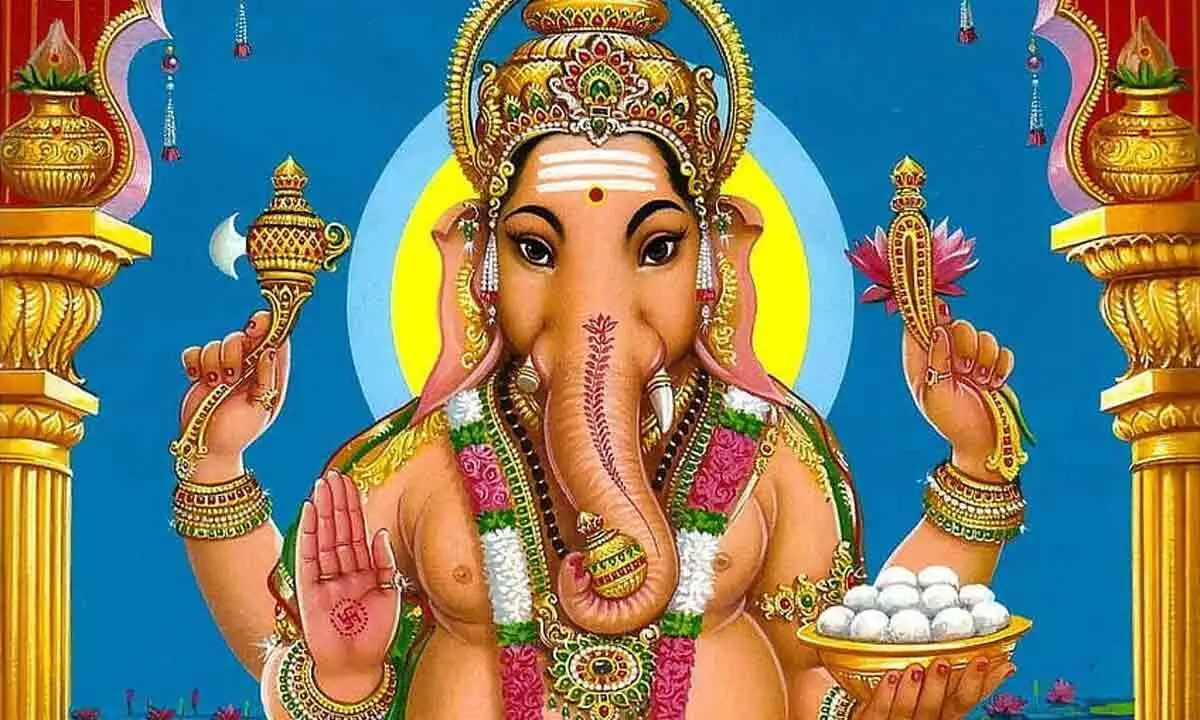Live
- APGV Bank services unavailable from Dec 28-31
- OMG! Who will control the temple?
- World Telugu Mahasabhalu begins in grandeur in Vijayawada
- Hindalco allocated coal mine
- Phulbani: 20-yr RI for raping minor
- Naveen hints at BJD’s support for ballot paper voting
- Dy CMs, ministers given charge of districts
- Farmer electrocuted in Bhadrak
- Amit Shah’s visit to Odisha postponed
- Berhampur: E-bike showroom catches fire
Just In

During the Ganesha vratam, the Ganesha Upanishad is read. It worships him as the Supreme Brahman. It is the summary of Vedanta philosophy. For lay worshippers, it is the ritual of visualising Ganesha as a god with form, worshipping him with various leaves (mostly medicinal leaves) and offering non-oily food. At the end of the vratam, the worshipper is expected to give some gifts to guests, saying that the giver is Ganesha, and the person accepting is also Ganesha. Ganesha is taken as the all-pervading Brahman and the devotee and, all around, tentatively becomes one with the divine
Ganesha Chaturthi, the day of Ganesha, the most worshipped god, has arrived. Ganesha is worshipped first in all rituals relating to any deity such as Vishnu, Shiva, Shakti or any other. When we take up any new task, we do not want obstacles, and we worship Ganesha with the hope that he will ward off any impediment on the way.
We have several stories of Ganesha. What we know best is that Ganesha is the scribe of the Mahabharata. He symbolises knowledge. He imposed a condition on sage Vyasa that he had to dictate the text with the same speed he wrote. Vyasa, too, imposed a condition that Ganesha had to understand what was told and then write. Thus, it went on, occasionally giving time for Vyasa to think and for Ganesha to rest in between.
The Sanskrit word gana means a team, and Isa means the leader. The two words combine to form the word Ganesha which means the lord of troops. He was the commander of the troops of gods. He got this position because of his innovative thinking. The other contender was his brother Kumaraswamy, also known as Muruga.
He was physically agile and had a fast-moving peacock as a vehicle. Ganesha was not as fit as his brother and had a mouse as his vehicle. The contest was to go around the universe, take a dip in all holy rivers and get back to their parents. Ganesha did some smart thinking and circumambulated his parents, Shiva and Parvati, who represented the whole universe. The condition was technically fulfilled, and he became the chief.
The yoga tradition mentions Ganesha as the deity at the starting point of kundalini. He is positioned at the chakra representing the earth, one of the five elements. The evolution sequence is space, air, fire, water, and earth. The sequence of chakras in the body are in the reverse order of the sequence of evolution – earth, water, fire, air, and space, from gross to subtle. Ganesha symbolises the transition from gross to subtle. It is a seeker’s spiritual progress, minimising bodily desires, practising purity of mind and attaining the chakra of knowledge.
Gods and wives have symbolic meanings. Ganesha is said to have two wives, Siddhi (success) and Buddhi (intellect). The son through success is Laabha (gain), and the son through Buddhi is Kshema (retaining what is gained). Whatever is gained – knowledge, wealth or position – has to be retained safely.
The immersion of idols in water after the weeklong worship is symbolic of rejuvenation. Anthropologists compare this with similar traditions of Ganesha, which existed in many Southeast Asian countries. Whatever it may be, the underlying symbolism is the immersion of the gross into the subtle, which is the aim of the seeker. Hence, immersion in non-clay Ganesha is not right. Sometimes, this practice becomes an event more for revelry and less for devotion, attracting criticism.
The symbolism of Ganesha’s person is difficult. Traditional astronomers explain by saying that the shape of stars is in the shape of an elephant’s head on that day of the year. Most festivals have such astronomical significance that we do not know now.
During the Ganesha vratam, the Ganesha Upanishad is read. It worships him as the Supreme Brahman. It is the summary of Vedanta philosophy. For lay worshippers, it is the ritual of visualising Ganesha as a god with form, worshipping him with various leaves (mostly medicinal leaves) and offering non-oily food. At the end of the vratam, the worshipper is expected to give some gifts to guests, saying that the giver is Ganesha, and the person accepting is also Ganesha. Ganesha is taken as the all-pervading Brahman and the devotee and, all around, tentatively becomes one with the divine.
(The writer is a former DGP, Andhra Pradesh)

© 2024 Hyderabad Media House Limited/The Hans India. All rights reserved. Powered by hocalwire.com







